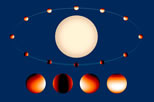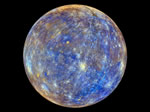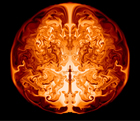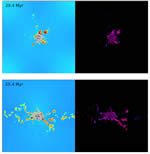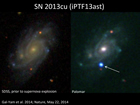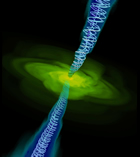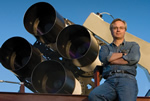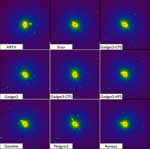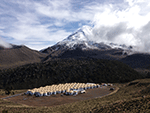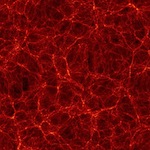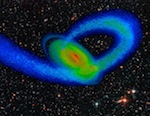Word doc
PDF (formatted and ready to go as a single newsletter page)
AGORA: Seeing the Invisible Elephant
You know the familiar fable about the blind men trying to discern the nature of an elephant simply from feeling the animal with their hands: one at the side of the elephant thought it was like a wall, one at the trunk thought it was like a snake, and one at the tail thought it was like a rope. Each accurately perceived the elephant in part, but their tactile observations were inconsistent with one another.
Astronomers are much in the same position in trying to discern the nature of the Universe. Most of the gravitating mass in the cosmos is cold dark matter--a slowly moving, weakly interacting elementary particle that holds together both individual galaxies such as our own Milky Way as well as entire clusters of hundreds of galaxies. But humans are blind to it: dark matter does not emit light or other electromagnetic radiation.
Thus, astrophysicists must rely on two tools to discern dark matter's nature: 1) observations of visible ordinary matter (which scientists call baryonic matter) that reveal dark matter's effects, and 2) supercomputer simulations to "reverse engineer" and test ideas of how dark matter might interact with ordinary matter to form galaxies.
Just one big problem: like the blind men studying only parts of the elephant but whose observational results are not consistent for the entire animal, astrophysicists have been able to model only parts of the universe because of limits to computational power. And the computer models have been inconsistent. Yet reproducibility is a fundamental principle of the scientific method: only if a result from an experiment can be independently reproduced by other scientists can it be regarded as robust.
Now, a new ambitious multiyear international project AGORA is figuring out how to reveal the entire elephant--and also discern which of the inconsistencies are due to complexities of astrophysics versus computational issues.
The challenge of scales
One major challenge, for example, has been numerically modeling astrophysical processes over the vast range of size scales in the Universe--all the way from the formation of individual stars to the formation of galaxies to the formation of the cosmic web of large-scale structure in the cosmos. At small scales, computational models can calculate such details as shock waves from supernova explosions, turbulence, and chemical composition of gas and dust with a resolution (ability to discern details) the size of our solar system. At gigantic scales, cosmological simulations trace the evolution of the cosmic web in volumes hundreds of millions of lightyears across. At such scale, even the biggest supercomputers have been limited to handling just gravitational interactions of dark matter, if calculations are to be completed in reasonable time (months) and at affordable cost.
And in the real Universe, both size scales interact: local star formation within individual galaxies is activated or quenched by the way galaxies "breathe" in and out the gaseous intergalactic medium. Often computational simulations do not create realistic-looking galaxies with the right proportion of stars in the central bulge compared with the flat disk or the right amount of clumpiness.
Major international collaboration
Now supercomputers are starting to have the computational power to simulate large regions of the cosmos with sufficient resolution and realism to create galaxies that look like ones actually observed. AGORA--an ancient Greek word for meeting place, and an acronym for Assembling Galaxies of Resolved Anatomy--aims to understand and resolve inconsistencies revealed among simulations.
AGORA got its start in a kick-off workshop at the University of California, Santa Cruz, in August 2012, under the sponsorship of the University of California High-Performance AstroComputing Center (UC-HiPACC). A second workshop was held at UCSC in August 2013.
AGORA, a collaboration of more than 90 astrophysicists and computational modelers in over 40 institutions in eight nations, is described in a flagship paper by Ji-hoon Kim and 45 co-authors that has been accepted for publication in The Astrophysical Journal Supplement. The collaborators have set up methodology to compare and contrast the results with nine variants of different codes (programs for computer simulations), which numerically handle the physics and the computation in significantly different ways. Although not the first comparison of supercomputer simulations of galaxy evolution, AGORA is the most comprehensive and the highest-resolution (finest detail). The project is expected to be completed in 2015 and result in many papers. Stay tuned!
–Trudy E. Bell, M.A.
Further reading:
The AGORA website is at https://sites.google.com/site/santacruzcomparisonproject/.
A UC-HiPACC press release is at http://hipacc.ucsc.edu/PressRelease/AGORA.html.
A UC Santa Cruz press release at http://news.ucsc.edu/2013/12/agora-project.html.
The flagship paper preprint "The AGORA High-Resolution Galaxy Simulations Comparison Project", for Astrophysical Journal Supplement, is at arxiv.org:1308.2669
The University of California High-Performance AstroComputing Center (UC-HIPACC), based at the University of California, Santa Cruz, is a consortium of nine University of California campuses and three Department of Energy laboratories (Lawrence Berkeley Laboratory, Lawrence Livermore Laboratory, and Los Alamos National Laboratory). UC-HiPACC fosters collaborations among researchers at the various sites by offering travel and other grants, co-sponsoring conferences, and drawing attention to the world-class resources for computational astronomy within the University of California system. More information appears at http://hipacc.ucsc.edu .
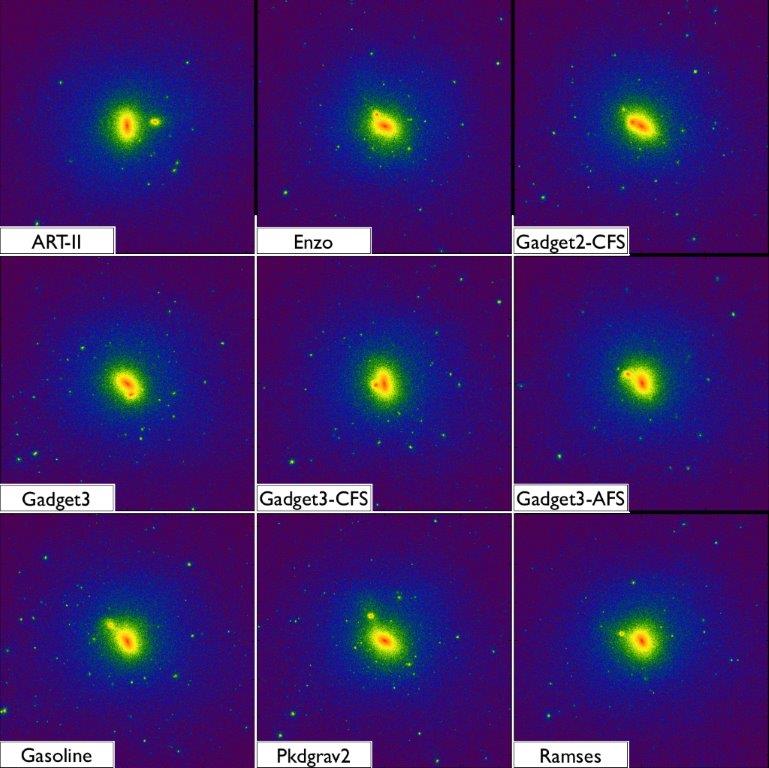
Differences in supercomputer simulations to be compared in the AGORA project are clearly evident in this test galaxy produced by each of nine different versions of participating codes using the same astrophysics and starting with the same initial conditions. The goal of AGORA is to analyze such differences to improve the realism and predictive power of supercomputer simulations, and thus astronomers. understanding of astrophysical processes. Credit: Simulations performed by Samuel Leitner (ART-II), Ji-hoon Kim (ENZO), Oliver Hahn (GADGET-2-CFS), Keita Todoroki (GADGET-3), Alexander Hobbs (GADGET-3-CFS and GADGET-3-AFS), Sijing Shen (GASOLINE), Michael Kuhlen (PKDGRAV-2), and Romain Teyssier (RAMSES)
